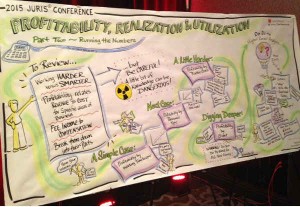
Finding the bottom line, or net profit, at law firms is not easy.
Law firms aren’t widget makers, and the business model is unique because the model centers on people not widgets.
At the same time, any firm that wants to stay in business has to establish a framework for understanding the drivers of profitability at your firm: The simple definition for profitability is revenue minus expenses.

The equation answers a simple question – has the firm made money or lost money? If a law firm wants to increase profit, it can either increase revenue or decrease expenses. In many cases, law firms seek to do a little of both.
There are two paths to profitability:
- Work Harder. In law firms, we look at two areas when we talking about working harder – realization and utilization. Utilization means essentially billing more hours. Realization is about converting attorney work into cash.
- Work Smarter. When we talk about working smarter, we want to focus on two key data points – fee income and compensation.
Profitability for any business is the ratio of revenue to cost for specific areas of a business. For law firms, it is the ratio of fee income to compensation.
Law firms should look in greater detail at these two areas to understand which parts of the firm are truly profitable, and that’s when you can start really making informed decisions to affect the bottom line.
* * *
Note: This submission followed a session by Joel Eaton, a professional services manager, titled “Profitability, Realization & Utilization” at the 2015 LexisNexis Juris Customer Conference in Las Vegas.

